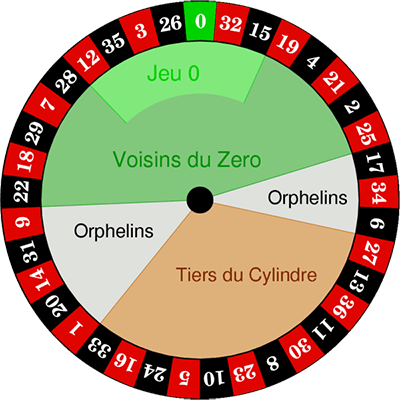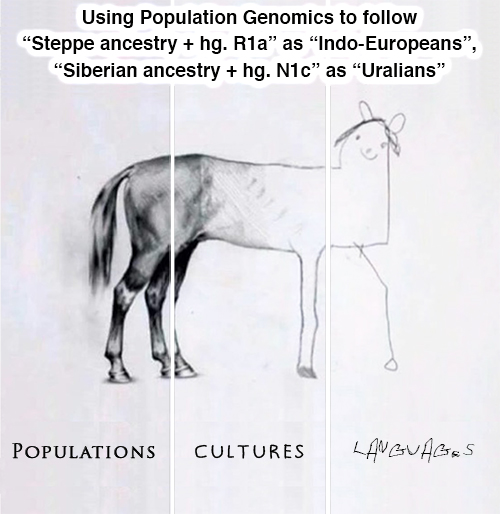This is a post I wrote in November 2018 to answer the absurd theories that had been published in the past 3 years. I decided not to publish it then, seeing how many “R1a/CWC=IE”-fans were at risk of having a stroke due to the most recent developments in population genomics. Now, in february 2019, it seems like the right time of general relax after some drought in genetic papers (and some more “steppe ancestry=IE” inventions) to publish it with some funny additions. For those of you interested in DNA “calculators” and similar tools like Eurogenes, you should read this before spending money to support xenophobic theories and misinformation about prehistoric population movements.
- 1. Haplogroup is not language, but R1b-L23 expansion was associated with Proto-Indo-Europeans
- 2. The history of the simplistic ‘haplogroup R1a — Indo-European’ association
- Related post: Germanic–Balto-Slavic and Satem (‘Indo-Slavonic’) dialect revisionism by amateur geneticists, or why R1a lineages *must* have spoken Proto-Indo-European
- Related post: Aquitanians and Iberians of haplogroup R1b are exactly like Indo-Iranians and Balto-Slavs of haplogroup R1a
- 3. Tips for dialogue with those supporting the ‘haplogroup R1a — Indo-European’ association
- 4. The “Indo-European Corded Ware theory” doesn’t hold water
Addition of 2019 to this series of posts:
Eurogenes-like aDNA crackpottery
Imagine a roulette. Players gather around the roulette table watching the wheel spinning, placing their bets. Let’s say red represents “Indo-Europeans from the steppe” and black “other theories”. Each number represents a particular model, let’s say that 3 red is the Indo-European Corded Ware Theory of Kristiansen, 12 red is the Yamna-Bell Beaker Theory of Volker Heyd, 35 black is Anatolian hypothesis, and 10 black is Out of India, apart from many others (usually more complex combinations). The roulette seems biased, so it is clear to any careful observer that the ball would likely stop within certain numbers around 0, but because there is a ball in perpetual motion, people bet again, and again, and again, and have fun… Now suddenly, some geneticists come and fix the system, with the ball losing momentum, and unexpectedly falls clearly into 12 red after bouncing between 12 red and 3 red.
NOTE. Volker Heyd published a very specific prediction of what would be seen in genetics with the Yamna -> East Bell Beaker migration, and that Yamna and Corded Ware would be different, and Mallory identified Bell Beakers with North-West Indo-Europeans (see here).
The outcome? Since there is no croupier, and no structure similar to a casino, and no set of clear rules, just a free roulette where anybody could bet with their own idea of what to expect, everybody is confused. Geneticists who fixed the system get to discuss among the general confusion of archaeologists and linguists which one won: “is it red? is it Jeu Zero? Or is it Voisins du Zero? Surely not the number only?” Because many scholars had invested (partly or otherwise) in 3 red or some combinations including it based on ‘kurgan peoples’, and it was really close. “Also let me see what would happen if I fix this or that screw, maybe the true result would have been 3 red, or 35 black…” People who had bet close to the final result question the details. “Which were the rules, exactly?” Everybody else just cries “the game is rigged!”, and “who cares about this stupid game!”. Sounds like fantasy? It’s not.
This is the “revolution” that population genomics was supposed to bring to anthropological studies, and how it has played out for the moment. The prize? For a few, like Volker Heyd or James Mallory, being told they were right. For everybody else, to know what happened in the past.
The problem is, few gamblers are ready to give up and pay. Instead of that, they have adapted to the new data rather quickly, and turned it into an infinite number of “involutions”. Amateurs (and even professionals) have gathered all necessary tools and samples to support their previously preconceived ideas, through the use of statistical-ish-looking analyses, fan-made calculators, shameless stretched PCAs, and similar deception tactics, in a true (a)DNA-based archaeological-linguistic crackpottery.
This trend seems to be promoted most especially from the author of tools such as Eurogenes and Global25, a hobbyist called Davidski, whose blog was created in the late 2000s with the obvious aim to promote his Polish ancestry and Y-DNA haplogroup R1a as the original Proto-Indo-European one (see e.g. my 2017 comments about this trend and the 2018 series on R1a), and whose friends and supporters apparently share his same bias and preference for disinformation and personal attacks. There is no interest about ancestral languages, or even about archaeological cultures of the ancient samples reported by geneticists: just the plain and simple association of ‘their’ ancestors with whichever culture they deem superior.
The money and effort that unsuspecting users absurdly spent on discovering one’s “ancestry” or “position” among ancient samples with this kind of hobbyist tools is only promoting this mob behaviour further, and complains by archaeologists about the misuse of population genomics for racist agendas abound (see e.g. news in 2016, 2018, or 2019). The evolution of hobby bioinformatics relative to population genomics is thus akin to the actions of metal detectorists in archaeology: they turned from helpers of an innovative technology in its initial phase to a nuisance when archaeologists didn’t need outsiders anymore, and are today outright obstacles to real archaeological research.
Now we have a shrinking part of the field of Indo-European studies that moves forward in discovering more and more details with new data, and a growing part of the field (including geneticists, academics and laymen) who have made their only aim to demonstrate that their previous hypotheses or beliefs were right.
NOTE. Those with some knowledge of the different developmental stages of Indo-European studies will realize that this behaviour is not foreign to the field. There have been already many periods of paralysis or involution to realize that this is quite common, and may span a whole generation of researchers. The difference is, this time there is obvious data like uniparental markers, which makes resistance even more absurd…
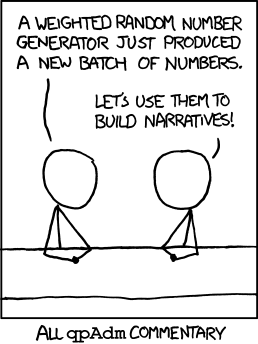
The Indo-European Corded Ware theory crumbles
A good way of seeing how the most reasonable theory is ‘winning’ is that theories full of holes need to resort to new (usually flawed) hypotheses. Looking at OIT supporters with their newest re-re-reinterpretation of data, I see they were always a good example of what would happen next to the BBC/R1b-Vasconic and CWC/R1a-Indo-European fans, and this is becoming clearer each day.
The Indo-European demic diffusion
Or: The “R1b-L23 = Indo-Europeans” (& “R1a-M417 = Uralians”) hypothesis.
The Indo-European demic diffusion model was based on a very simple assessment: R1b-M269/L23 and R1a-M417/Z645 lineages expanded with different peoples, associated with different cultures (Yamna-Bell Beaker and Corded Ware) ergo they spoke different languages. Given the later evolution of their cultures in Europe and Asia, tracing these cultures back, their languages had to be necessarily identified with Indo-European and Uralic, respectively, which has very interesting consequences in linguistics, since it helps to select among conflicting theories.
In the past two years, this model has been confirmed again, and again, and again, and again, and again, and again… in population genomics. Although I have changed many details depending on the most recently published papers (see e.g. my predictions for 2018), the most obvious assessment still stands: it is now also supported by the different “steppe ancestry” expanded with Yamna and Corded Ware, and becomes each day less likely to be challenged (see here on the very Yamnaya-like Yamna Hungary and early Bell Beaker in France of likely hg. R1b-L151).
For those with an anti-steppist bias, yes, in simplistic terms it means a confirmation that hordes of steppe nomads conquered Europe and Asia. Except, instead of violent horse-riding armies, it’s actually more like successfully adapted grassland herders from the Eurasian steppes using their economic advantage in the steppes and the demographic advantage given by the previous expansion of the plague through Neolithic Europe to occupy neighbouring regions. Leading males among the different clans showed then more success in having surviving offspring, with their sons in turn being more successful, and so on. Anyway, the caricatured picture of opponents of the theory was not that different from reality.

Like all theories, it needs its exceptions. As it seems right now – similar to what I described would happen – only within chiefdom-based communities (like Sintashta-Potapovka dual settlement-herders model, or the Baltic Iron Age chiefdoms) – or after some peaceful, non-expansionist period – were different lineages able to integrate (“resurge”) and prosper in these societies. This was especially the case in societies with a big population size, as shown by the varied haplogroups found in the Balkans, in the Fertile Crescent, or in Iran/Turan.
NOTE. You can read more about the model in detail in the series of books A Song of Sheep and Horses.
The Indo-European Corded Ware theory
Or: The “steppe ancestry = Indo-Europeans” (& “Siberian ancestry = Uralians”) hypothesis.
Kristiansen’s “Indo-European Corded Ware theory” (IECWT), which is backed today by a surprising number of Danish academics, apart from other geneticists and many fans, was also based on a very simplistic concept: Indo-Europeans expanded with “steppe ancestry”.
NOTE. I’m not saying it’s ‘wrong’ to redistribute among Danish colleagues the ‘points’ related to the impact factor of the journals they publish in. You scratch my back today and I’ll scratch yours tomorrow, that’s fairly common in publications. But, alas, maybe this Danish endogamy was not a good idea in the first place for a (supposedly) international lab, if they wanted to obtain a neutral assessment of the data. Another problem is, if this theory goes south, as it seems, the Danish scholarship would have gone from famous to infamous in less than 5 years, which must be some kind of record. This is a good lesson for future publications of other labs aspiring to grow beyond their local academic limitations.
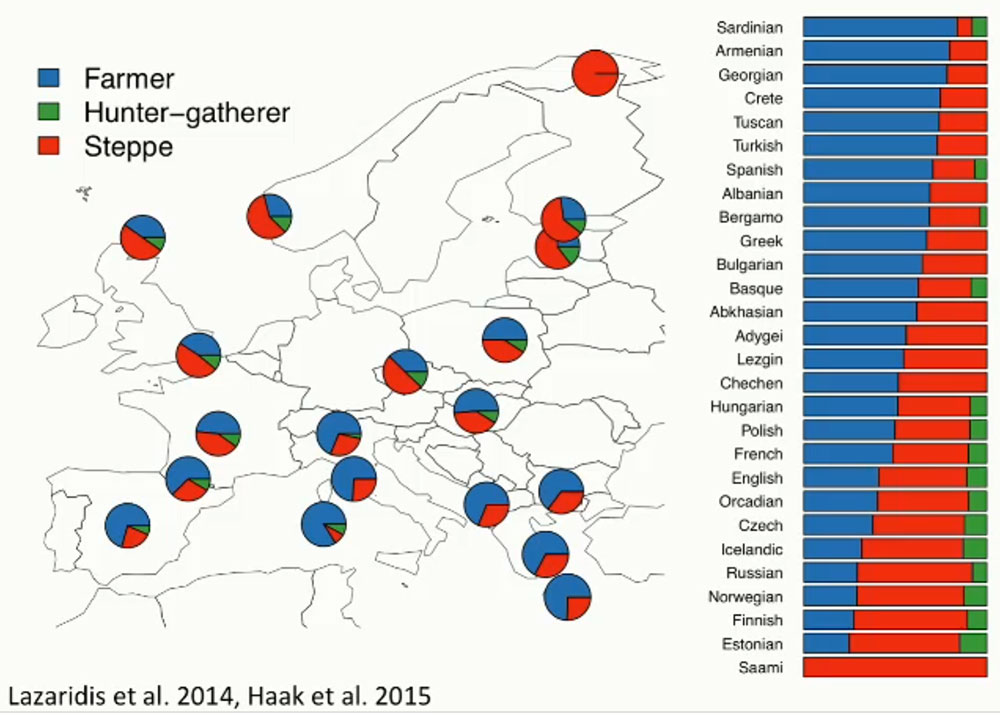
Compared to 2015, when everything must have seemed really nice and simple, and IECWT fans were patting each other on the back nonstop, it is evident that this hypothesis is needing more and more pet theories to fill in the bigger and bigger holes created by every new paper that gets published.
Basically, we have now the following theories, for lack of a better name, more or less in order of appearance (comedy courtesy of the Copenhagen group, and especially of Davidski from Eurogenes and friends):
First, the two pillars:
- The Indo-European shapeshifting horde hypothesis: haplogroups are so from the 2000s… “ancestry” is the future, invest!; so, here you have, the key “Yamnaya ancestry”, pure Indo-Europeans, we proved it, you are welcome; no, wait, more like some “steppe ancestry” ancestral to Yamnaya?; no, wait,…more like “northern Caucasus ancestry”?? Whatever, one ancestry = one language, so Yamna has more, Corded Ware has less, Bell Beaker has even less, Logic 101: more is more than less, and less is less than more, hence Yamna (R1b) -> CWC (R1a) -> BBC (R1b) migration, because “ancestry”.
- The Nganasan reindeer horde hypothesis: let me test ADMIXTURE of modern Uralic peoples, hmm…hey, something pink appears in K=8! Nganasans more pink than anyone? cool, let’s call it “Siberian ancestry”!; also haplogroups work so well for Uralians, not like Indo-Europeans, even modern distribution maps! look, “N1c=Uralics”; also if not pink then choose another color; no, not the “Steppe” color, that’s Indo-European, don’t be crazy; so maybe Devil’s Gate, see this qpAdm (2% of whatever wherever!); or maybe East Asian, see these clines I just drew; or maybe EHG, see my PCA!; whatever, really, who cares about Uralic peoples…
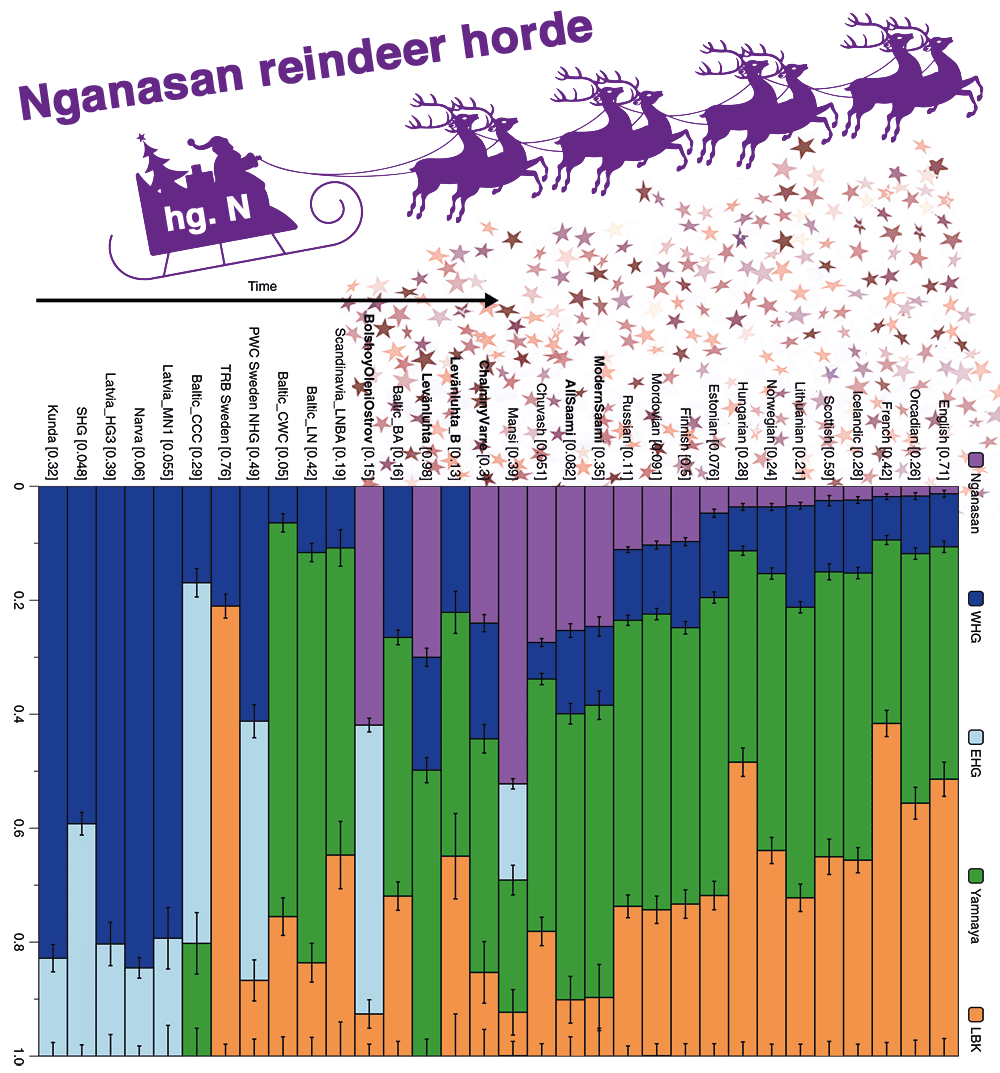
Then, the consequences:
- The Variable relevance of ancestry argument: exogamy exists, but only when I say so.
- “Steppe ancestry” speaks Indo-European; it’s the same for Yamna and Corded Ware, up to 75%!; only a late outlier, you say? and CW has different “steppe ancestry” only from Sredni Stog?? it doesn’t matter (or from where or when), because
float steppe_ancestry () {return steppe_ancestry()}; also “steppe ancestry” from the Caucasus is not the same, cranium not “Europoid” or “Uraloid” enough, not “R1 rich” enough, look the size of the femurs!; or maybe they are, see this PDF I googled, the kurgans!; but I think now it’s not IE, only 10% Anatolian, it was exogamy for sure!; but maybe yes, they are, Armenia Chalcolithic has it, look Proto-Anatolians! then maybe through Maykop or Kura-Araxes, see this other free PDF; or maybe not, because not dolichocephalic enough; maybe Armenians? have we tested lactase persistence yet? - “Siberian ancestry” speaks Uralic, this 2% “Siberian” in Estonians proves it; or maybe not, then hidden Volosovo HG in the Urals, so perhaps this 5% EHG and Comb Ware-like ancestry; or maybe not, and EHG is Proto-Baltic, then “Siberian ancestry” for sure in Lovozero, and hg. N1c!, there you are, told ya, end of discussion; oh, too soon, you say? then linguistics is not science, but anyway let’s say from Devil’s Gate, or from Lake Baikal, because 0.5% Nganasan or Glazkovo, so maybe East Asians or something; or maybe not, then West Siberians, look Sintashta outliers with WSHG and hg Q, and oh god so close in my PCA!; or maybe it’s clines, so many many clines, look Scythians and Turks and whatnot; but not Corded Ware clines, because Tarand-graves and haplogroup N from the Middle Ages are the True Uralics™…
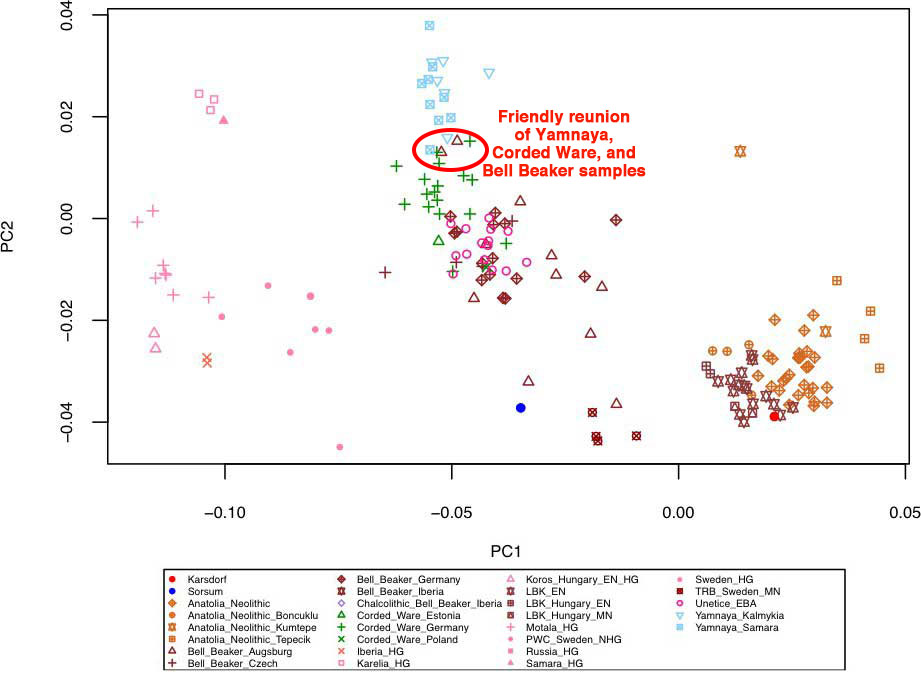
- The Variable relevance of haplogroups argument: ancient male lines distinguish between populations, but only when I want.
- The North Caucasus barrier between the “R1-steppes” and the “non-R1-Caucasus”, so obvious, also look “N1c-Uralians”, also evident, Y-chromosome is superimportant, J or G could not speak Indo-European, also they’re southerners, don’t be crazy! Different ancestry in R1a-R1b? gene flow, duh!; similar ancestry in R1-J? also gene flow, duh!!; and have you seen this dolichochephaly-brachycephaly distribution map from 1934? so so similar to the map R1-others!
- The steppe–forest-steppe barrier between “R1b-L23–steppes” and “R1a-M417–forest-steppes“? no, no, NO; few samples, you know, hidden pockets here and there, lots of bottlenecks, founder effects,…haplogroups are too variable; and why do we call it “R1-rich Indo-Europeans”? We didn’t make this up! Also exogamy doesn’t work for R1a, my qpAdm and my PCA would know, see these other PDFs, it’s so complicated [also wait for it…the distribution map of epicanthal fold and its similarity with N1c!]
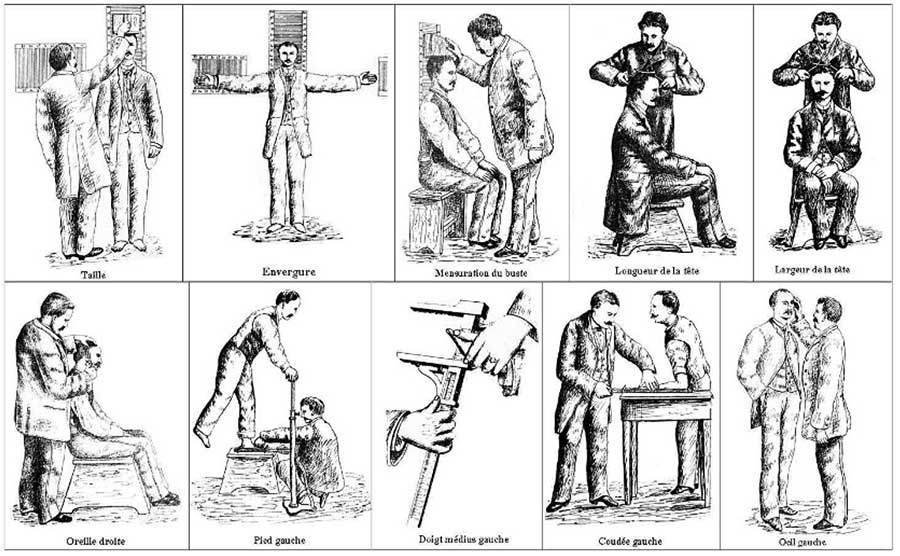
- The Variable relevance of archaeology argument: cultures and their relationship are important, but only if they fit my qpAdm.
- Yamna was The Indo-European community, sure R1a-R1b; or maybe not, but not important, because steppe folk = steppe language; also ‘steppe-forest’ sounds like ‘steppe’, must be the same people, no? all BFFs from Eastern Europe, the eternal IE fatherland; Bell Beakers come from Corded Ware, because look this vase I googled, so similar, also R1b is bottleneck of R1a; or maybe not, then BBC from wherever, but CWC comes from Yamna, because kurgans, and R1a is bottleneck of R1b, see my stretched ownPCA®, they are so close, I used the same colors and all!; or maybe not, but sure from Khvalynsk, all share copper y’know, see my qpAdm, 40% shared ancestry, sure IE-speaking genes!; or maybe not, but then from Sredni Stog for sure, and it’s the same, see this free PDF from 1983, horse bones!; or maybe not, and it’s from the forest-steppe…but it doesn’t matter, we all know R1a were (always) Indo-Europeans.
- Volosovo HG were Uralians because Indo-Iranian loanwords; were replaced by CWC, you say?? then not, of course not, better Lovozero from the Kola Peninsula, because haplogroup N1c and “Siberian ancestry”; Laplandic, you say? that’s a thing?? then they are “Para-Uralic” whatever that means, Uralians then Arctic nomads, because Nganasans; no reindeer horde ever happened? really?? then Seima-Turbino, for sure, look this PDF I found, copper is the key; WUT!? Karasuk, Mezhovska, Tagar,… all R1a and “steppe ancestry”?? then East Asians, because 1% “Glazkovo” in Estonians, only 0.95% in Lithuanians, told ya! must have teleported; also one Late Trzciniec so “Balto-Slavic-like”, my grandpa clusters there too, see my stretched ownPCA®, and he is no Uralic, I tell ya…; Finnish IA is so “Germanic”, or maybe not, but then a stupid foreigner fishing 500 km to the south, not 20 km to the west, because strontium isotopes and shit; or maybe not, but it doesn’t matter, because N1c=Uralics + R1a=Indo-Europeans, everybody knows that…
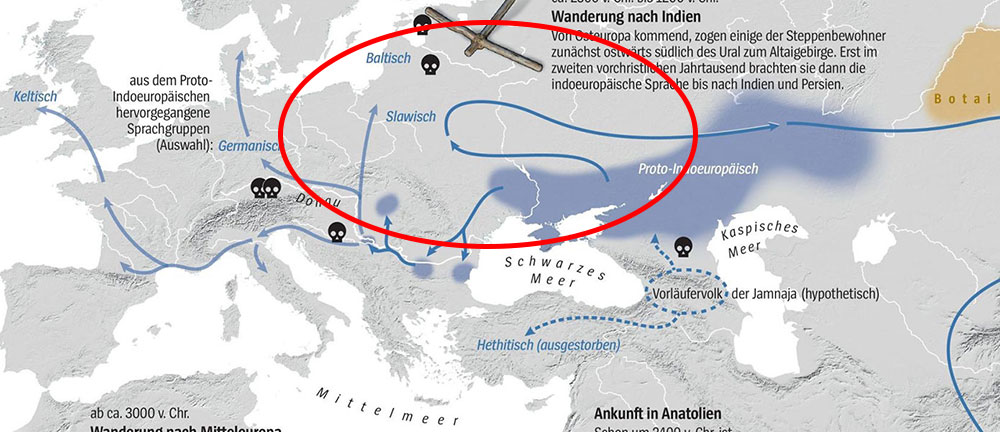
- The Variable relevance of linguistics argument: languages and dialects are important, but only if they fit my qpGraph.
- The Old & Young Indo-Slavonic hypothesis: Indo-Slavonic split first, with Sredni Stog (before ca. 4000 BC, because Alexandria spoke IE, it has R1a!), but Graeco-Aryan split later than Northern IE, and Indo-Slavonic was the last to split off of the Graeco-Aryan group (so later than 3000 BC), so Sredni Stog split earlier than Afanasevo (before ca. 3500 BC) and also later than Proto-Greek (after ca. 2500 BC?), so maybe in the Srubna expansion, or Slavic-like Scythians, or something like that; absurd paradox, you say? No problemo, see my F3 statistics right here, great p-values, also linguistics is not a science, so who cares.
- The Indo-Germano-Slavonic hypothesis: Tocharian (Afanasevo) and Italo-Celtic (Bell Beakers) split first, then Indo-Germano-Slavonic (with Corded Ware), because of the word ‘fuck’…but Corded Ware split first from Yamna, or even earlier with Sredni Stog, and then Yamna? A more absurd paradox, you say? Who cares, Danish people say Danish CWC spoke Germanic, because four ‘semitic’ substrate words, so surely Semitic from TRB; or not, but who cares, that’s not science, “steppe ancestry” and R1a is; also my qpGraph gives the best language tree; look! this glottochronological language tree from a free PDF looks exactly like it, seems legit.

- The Uralic from the east hypothesis: Uralic is from the Urals…because why else call it “Uralic”? duh!; or maybe not, but then from beyond the Urals, because so so impossible from the west, because Corded Ware = “steppe ancestry” (and “steppe ancestry” = IE, duh!); then Indo-Iranian loanwords from Andronovo, why not, I believe this, so Uralic from Siberia or Baikal, great metallurgy, great Russian PDFs, I used Google Translate!; Palaeo-Germanic loanwords? then Finland and the forests were Germanic, because look what %% of “steppe” in Finland IA, the PCA of Estonia BA so Scandinavian-like, great Nordic people!; so surely “Samoyedic-Samic” and “Finnic-Permic-Volgaic” or whatever, splitting 500 BC from wherever, my qpGraph proves this, my PCA talked to me; and of course never ever CWC or R1a, no way, that’s impossible, are you not seeing these great numbers?!
- The Variable relevance of toponymy argument: there are no Uralic toponyms of Single Grave or Central European CWC territory (ca. 2900-2500 BC), so no Uralic speakers were ever there, no way, I would know, I live there, I know the people, the places, not Uralic-looking at all, we don’t speak that. Balto-Slavic and Germanic peoples from eastern Fennoscandia and northern Russia since CWC until late Iron Age (ca. 2900 BC – 500 AD)? That makes so much more sense, in fact I’m sure, because “steppe ancestry”, and R1a, and look this plot I just made, I’m the red dot right there, and I’m not Uralic, so Estonians, Mordvins, Permians…must be acculturated Indo-Europeans! great great discovery, fst is enough hypothesis for me; lack of IE toponymy, you say? my ancestors moved a lot, also Nganasan nomads sure liked renaming places, and who said toponymy mattered, not me.
- The Yamna Hungary -> Corded Ware hypothesis [newest from Anthony, not Copenhagen yet, but wait for it]: Corded Ware not related to Yamna, not speaking Indo-European, they learned the superior language, patron–client relationships and stuff, look at Usatovo’s cranial size!; “steppe ancestry” in CWC, you say? Usatovo is Trypillian-like?? then yes, CW peoples come from Yamna, of course they do, were totally Indo-Europeans, migrated from the Dniester, Prut, or some place; wait, R1a not in Yamna yet, you say? and first CWC dates are from Poland?? Hmmm…then Yamna in Hungary to the north into Corded Ware and to the west into Bell Beakers, let me draw these new arrows…; languages? Oh, hmmm…can I say Indo-Germano-Slavonic to the north and Italo-Celto-Germanic to the west? That’s double Germanic, I know, but Kortlandt does it, and I used two arrows! Modelling is fun! test me again, I like drawing arrows.
- The Graeco-Aryan from Corded Ware ancestry hypothesis: Greece Neolithic outlier (probably ca. 4500-4000 BC) is from early corded pottery (not related to the Corded Ware culture, but who cares, it’s ‘corded’, no?), I visualize archaeology & language through ADMIXTURE colours, so it’s Proto-Greek for sure, also look how close they are to my CWC-related cousin in the PCA!; and also Proto-Greek from Sintashta (ca. 2000 BC) or Srubna (ca. 1500 BC), because Bronze Age Balkan sample has lots of “steppe ancestry”, so much CW-like, great great R1a guy, also who cares about language estimates or cultures; but never ever from previous Yamna settlers or R1b, my qpAdm knows without testing, it talks to me, says “R1a=Graeco-Aryan”, “R1a=Graeco-Aryan”, I’m the ancestry-whisperer, so so good with AdmixTools; Proto-Greeks were R1b-L23, you say?? then I don’t care about Proto-Greek, or Graeco-Aryan, or linguistics, it’s not science anyway, only my numbers are.
- The Indo-Europeans from the forest hypothesis: Indo-Europeans come from Corded Ware, because Gimbutas, and Kristiansen, and a bunch of people of the 1990s with free PDFs I just googled; or maybe not, but certainly from the forest-steppe or forest, great great hunter-gatherers, had elk for lunch; or maybe not, but from eastern or central-eastern Europe, like granddaddy; because R1a, and a chariot in Poland, and lactase persistence, and anthropometry, what great craniums we have; also Balkan outliers from 4500-4000 BC look so much like Corded Ware in my stretched ownPCA®, must mean something, let’s find some fitting qpAdm and p-values together!; also, R1a is the be(a)st so they are ‘pure’ PIE, but that’s not the reason, of course not, steppe R1b peoples must Basques, or Turks, or…something.
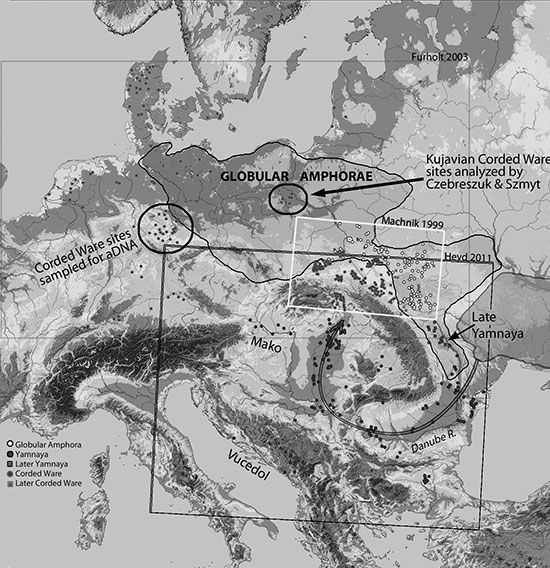
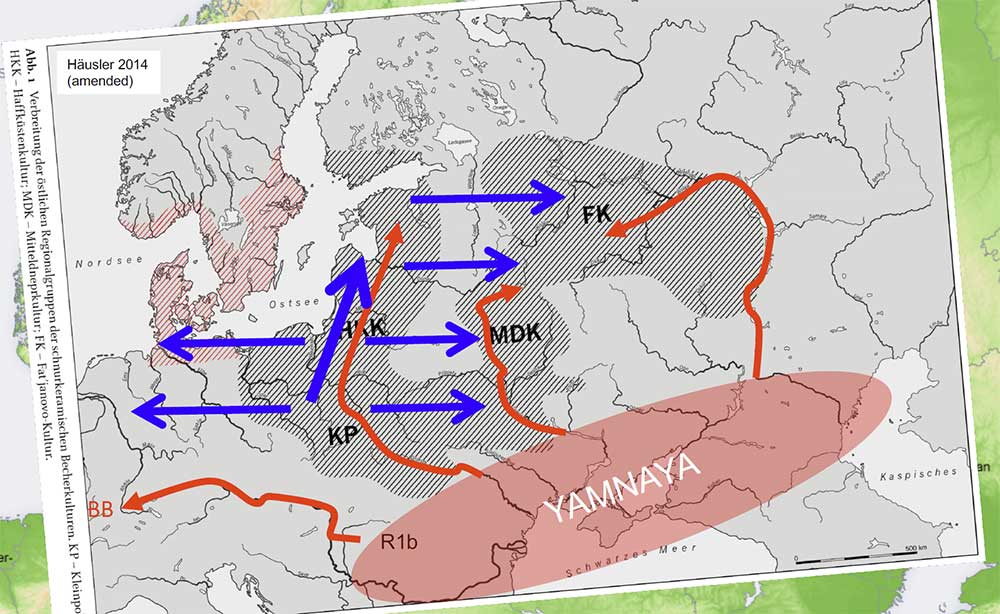
- The Italo-Celtic Bell Beakers that expanded with R1b-L151 and turned into Corded Ware peoples to travel to the British Isles as Bell Beakers but also Celtic from the Atlantic façade hypothesis (wut?) [Courtesy of Kristiansen’s latest presentation]: surprise, CWC from Denmark is Germanic! Oh and Balto-Slavs from somewhere, traveled north or something, who cares; oh yes, and many many arrows from Yamna to basically everywhere, just in case, I just drew them with Microsoft Paint®, must mean something; also look, Koch likes this, see? Atlantic façade Celtic, told you, “steppe ancestry” in Basques and Iberians so “Basque=IE” and “Tartessian=IE”, whatever, just please everybody accept CWC-Denmark is the Germanic homeland, I’ve been saying this my whole career…pretty please with sugar on top?
- The Fearsome Tisza River hypothesis: Balto-Slavic/Germanic from East Bell Beakers of hg. R1b-L23? from Hungary?! unacceptable, let me see, hmm…these tens of thousands of Yamna settlers of hg. R1b-L51 couldn’t cross a red Tisza River, couldn’t swim you know; or were Vasconic or Turkic speakers, because brachycephaly and EEF and other complicated stuff I just made up; they died, that’s for sure, see my qpAdm – and the p-values, what values! so totally dead; also dates don’t fit, and look these vases from the Rhine, my qpGraph predicted it; the true R1b-L51 came from this CW group in The North, huuuge bottleneck from true R1a Indo-Europeans, I whispered and my PCA answered me, see this graphic, the X mark of death!; or maybe not, maybe R1b-L51 came from the west, they were Basques!; that’s not essential to my point anyway, if I ever have one, but whatever is published next is wrong, my RStudio has foreseen it; but R1b-U106 was Corded Ware, even more for sure, superfriends with R1a, I would know, we are all R1a and U106 friends here in The North, Winter’s coming and all that.

- The I really really don’t care argument, because I really really don’t care, because I’m not invested in this theory or haplogroup, only in The Truth™; but I’m always right because “steppe ancestry”, and see my qpAdm, and my stretched ownPCA®, and what do you say about these great p-values?!; also our R1a ancestors were never Uralians, impossible, I would know, I have 80% steppe ancestry, OK?! But everyone else was African, or Vasconic, or Siberian, or East Asian, or whatever, who cares, not me, I am not that, but why don’t you accept it??; and I wouldn’t mind, I would admit it if I were wrong, because I really really don’t care, but I’m always right; also my region/haplogroup is the be(a)st, we are Conan’s hyperboreans, so cool, white as the milk we digest; but everybody else is an idiot and don’t ever ever again mention this crazy theory because it hurts so much; also I couldn’t care less, I’m here for The Truth™, not this shit (oh, and for the $$).
- The We need more samples argument, because really 300 Bell Beaker samples, 100 Corded Ware, and 200 from the Ch.-EMBA steppe and Afanasevo, apart from 5,000 samples from prehistoric Europe and Asia, are obviously not enough (sing with us); but of course 20 samples were so so enough to say “steppe ancestry = Indo-European”, how dare you!? I’m the ancestry-whisperer, so great with R and EIGENSOFT and AdmixTools, my PC talks to me, I can even code my way out of any problem, see?
if (!problem) {cout << "because steppe ancestry"} else {cout << "my qpAdm and PCA prove" << " my_theory " << "is right, but we need more samples"}. Also I dislike this paper's interpretations, give me all samples to test them (spoiler alert: they are going to be so wrong, and I'll be so right, ha!); but not me, I don't have to care for hypothesis, or power, or threshold, only keep trying things until it looks right to me, and publish just the numbers I like; and trust me, I can interpret my numbers better than anyone, ask me anything, I'll google some free PDFs, maybe a YouTube video, and if you don't believe me you are not very good at this.
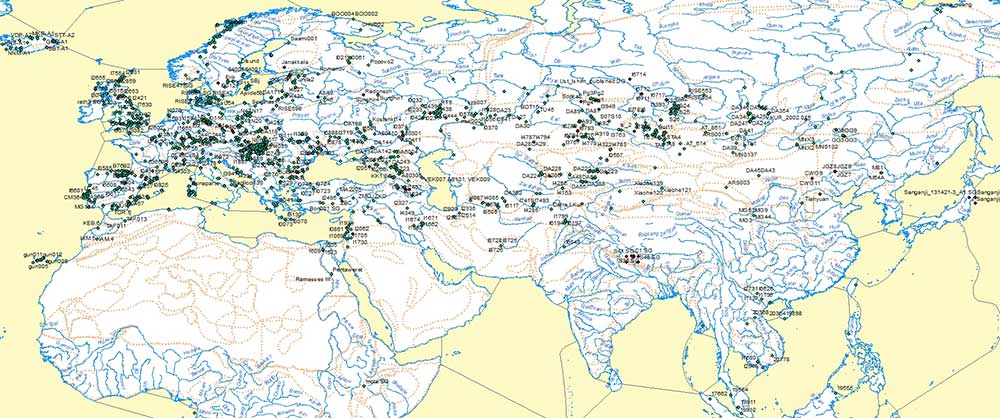
- The Free samples but not me strategy: oh yes, here you are, plebs, the samples as BAM files, because journal editors say I have to, so you are welcome, good luck downloading one a day (if the server works haha!), and converting to rsid, and extracting overlapping SNPs, you'll merge them wrong anyway, our qpAdm and PCA are the only valid ones; also please let me use free samples and datasets from your paper for my plots, I need them processed too, I don't have time for stupid BAMs; no I don't share my merged files, that's putting things too easy, only friends allowed, 'others' go and reinvent the wheel; and the modern samples I have I keep for myself, and publish (and sell) results, I deserve it, because I'm such a plot magician, here it is your grandma among CWC samples, pure IE I tell ya, it's 7$...but everybody else share them with me for free; also share with me archaeology and language papers, and data and knowledge, always for free, that's not science anyway, only my computer does True Science™.
- The Variable respect to indigenous peoples strategy: [see recent criticism against David Reich and Harvard] The Copenhagen team cares sooo much about Amerindians, and Africans, they are true animists' friends, they listen to Lapita's spirits! Willerslev is like Mother Teresa, not like that evil guy from Harvard...The Danes even have linguists to interpret genes!; but Finno-Ugrians are not indigenous to their lands, they are too First World, so probably from the Arctic; or maybe not, then from some cave in the Urals; or maybe not, then from some lost Siberian forest, or some East Asian mountain, or, really, who cares what they were, they displaced indigenous Germanic peoples from Fennoscandia, and Balto-Slavs from Russia; because Estonia_BA are CWC-like R1a hence Balto-Slavic, and Finnish_IA has 'Scandinavian' ancestry hence Germanic, also 'textile' vases look like 'corded', see the map I just googled!; I should've known, I am 80% indigenous Germanic + Balto-Slav! Give us Fennoscandia back, you evil horde!!
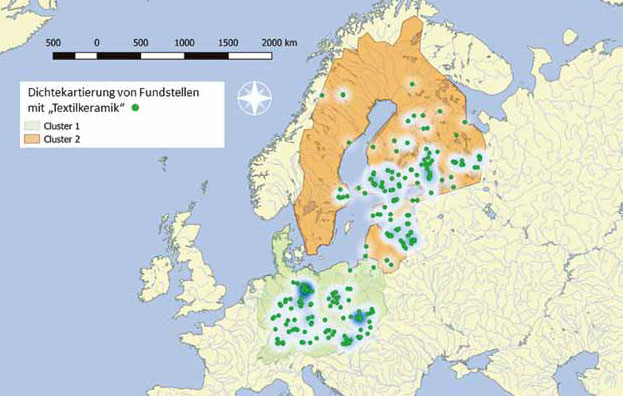
- The Being wrong is shameful but not for me attitude: because everybody else is so wrong, and that's so horrible, they should change profession and just leave me alone to explain everything; also who are these guys anyway, not PhDs, or not linguists, or not archaeologists, or not geneticists, or not very good with RStudio, like I am, why are they even trying without my approval??; so many agendas, and so many idiots, but not me, most impartial and highest IQ ever!; when have I been wrong?? of course not, haven't you seen my numbers!? have you perhaps better numbers? you can't, I'm the ancestry magician; you'll see, this haplogroup/ancestry will pop up here, and here, and here, because numbers; they didn't? ever?? then in future papers, of course, I don't need proof or confirmation, I dream with PLINK flags!; did you see these new graphs I just made up? totally confirm the BS I wrote five years ago nobody cared about! I'm so good I alone can validate myself; also I don't know how everybody else keeps going on, really, probably mentally unstable people ('crazy', 'low-IQ', 'cheating', 'fake',...), not like me, stablest mind ever!
A glimpse into the future
Apparently, as with anti-vaxxers relying on some flawed retracted paper from a million years ago and infinite online fake stories, once something controversial (like the "steppe ancestry = Indo-European" hypothesis) has been published, you can only have patience and repeat why this whole political movement is unscientific. You don't have to prove that vaccines don't cause autism, just as you don't have to prove that "steppe ancestry != Indo-Europeans", only because some guys said so.
The worst part is that you can say how flawed their arguments are at first sight, but no one has the time to invest in discussing why their unending inventions and flawed test designs, results, and interpretations are wrong, so with each new unanswered invention they feel more confident under a pile of (mostly contradictory) assertions, more bound to their support groups, and more disconnected from reality, and thus more and more conspiranoic and aggressive about dissenting opinions.
NOTE. There is a fitting description in Twitter, #zeropercentscience, to classify certain theories like this one, because this is what this is becoming, a whole crumbling theory reaching a level of 0% science and 100% personal or professional interests.

The good news is, this pattern is becoming more and more obvious each day, for anyone to see. The unending pet theories that can be created and supported based on "ancestry" also confirm that Y-DNA is still the gold standard in assessing prehistoric migrations with population genomics, coupled with archaeology and proper migration models, and - in the case of known language families - with linguistics and reconstructed dialects and their approximate estimates.
I was a little concerned that genetics was being misused to support many different theories and that this would become yet another tool to continue infinite pet theories, (as I said long ago). Realizing that the IECWT proponents have needed so many pet theories to adapt to the new papers, and these examples above only in the past two-three years, gives some relief to those of us who look for stability in the models of migration, because only one theory will withstand proper scrutiny.
As you can see, all these inventions of the CWC-IE theory are strikingly similar to the parallel unending developments of the OIT or R1b-Vasconic supporters, where each new paper adds to the mounting pet theories surrounding their main hypotheses: that Sanskrit was spoken in the Indus Valley Civilization, or Vasconic by R1b peoples in the Franco-Cantabrian region, for thousands of years before steppe peoples arrived.
Population genetics hits the wall of (dis)beliefs
A recent comment reminded me of the suspicion that we all have from time to time about the motivations for all this resistance to change, or simply to accept any version of reality that challenges the own beliefs. I think these reasons can be described in very simple terms:
NOTE. A clear drawback of this approach to classify the hidden reasons people may have is 'mind reading', a common way of jumping to (wrong) conclusions in a cognitive behavioral environment. Nevertheless, I feel that there is one of these three biases in the vast majority of professionals and amateurs who like to discuss population genomics from a prehistoric and historical point of view, after two years of observing their behaviour.
- Reactionary revisionism: it would apply mostly to those with attachment to previous academic theories (the own ones, or those of other people). For example, those obsessed with an Indo-Slavonic group, or with a western origin of Celtic in linguistics; or those obsessed with Corded Ware from Yamna, or Bell Beaker from the Rhine in archaeology; and there is some sort of "Yamnaya ancestry" tradition in population genomics already, no doubt because of the fear that many researchers have of retraction, or simply admitting that their interpretation was wrong. These supporters usually believe their 'great' theories are true "unless proven otherwise", as if they had somehow shifted the burden of proof for others.
- Nativist chauvinism: it applies to people eager to prove some nation-building myths, or even religious myths. For example the myths of Basques from Franco-Cantabrian Cro-Magnons, the myth of the Indus Valley Civilization speaking Sanskrit for (tens of) thousands of years of Hindu nationalists, or the myth of Uralic continuity in Finland since the Mesolithic are well-known ones. These ideas are infinite, though: there are as many as national, regional, and local myths; one the of most prevalent today is that Balts and Slavs derive from Corded Ware (how?), or that Baltic is "the most conservative PIE dialect" (since when?), so Balto-Slavs are native to their regions (wut?). People prefer their communities and languages to have been in their 'great' territory as early as possible, and with as little 'foreign' influence as possible.
- Haplogroup/ancestry fetishism: Haplogroup fetishists identify, absurdly, with their supposed ancestral granddaddy. Ancestry fetishists are obsessed with their own (or their family's) ancestry percentages and position in the PCA, especially compared to ancient samples, which have actually nothing in common with them. Most of these people don't even know their most recent grandparents (they could be the worst serial killers who have ever existed), but there is some kind of heroic aura of the own ancestors. If their ancestor is 'great' in some way or another, then they are also 'great', or so the story would go.
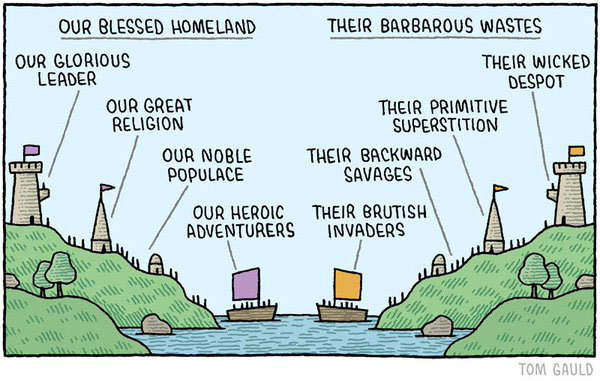
These are sort of 'pure' reasons, but the most common ones are combinations of them:
- How would you distinguish a nativist chauvinist from some northern or eastern European country from a haplogroup/ancestry fetishist? Let's say Yamna was fully R1a, and then also Bell Beakers, while Corded Ware had undergone a bottleneck under haplogroup N, with a "steppe ancestry" pattern similar to the real one. How many of those supporting "Corded Ware = Indo-European" would change their current view? These are haplogroup fetishists. Just like many northern Europeans defending today "Yamna/Bell Beaker-R1b + Corded Ware-R1a = IE", a typical example of nativist chauvinism defending "Yamna-R1a + Corded Ware-N1c = IE" in this hypothetic case would be probably found in certain modern (Indo-European-speaking) countries where haplogroup N is relevant, such as Sweden, the Baltic, or Russia; in all other northern European countries probably haplogroup fetishism (and thus "Corded Ware=Uralic") would be the rule, although ancestry fetishism (based on "steppe ancestry") would be divided.
- If Corded Ware and Sredni Stog were mostly R1b, and Yamna and Bell Beaker were mostly of hg. I (I2/I1), with a similar distribution of "steppe ancestry" to the current one, whereas R1a would be limited to northern Eurasia and eastern Fennoscandia, and thus coming from the east... Would northern and eastern peoples obsessed today with R1a agree for a common route of hg. R1b and I with Yamna and Corded Ware, as they are doing right now? Would they accept an eastern, late origin of R1a with non-IE peoples? I think lots of nativist and fetishist eastern Europeans would be looking for some batshit crazy theories whereby Lovozero Ware and Glazkovo and the whole Northern Eurasia would be Balto-Slavic, or be forever expecting R1a to pop up somewhere and somehow from a "hidden pocket" in Corded Ware, as peoples of haplogroup N expect from Comb Ware groups today...
- Would an anti-steppist of hg. J and originally from the Balkans or the Middle East (say, a modern Greek or Iranian speaker) be opposed to the steppe hypothesis if haplogroup J had been found only in the steppe associated with "steppe ancestry" as the main Indo-European marker, while haplogroup E dominated over the Middle East and south-eastern Europe until the Chalcolithic expansions? Similarly, would someone of hg. J and originally from a Semitic branch be opposed to the hypothesis of an expansion of Afroasiatic from Italy into Africa, if this haplogroup was common in southern Europe but not in the Middle East or Africa until the Bronze Age? It depends on whether the region or the haplogroup means more within their previous belief structure...
- True chauvinists without a haplogroup/ancestry fetish can accept results, even if they do not fit their best nationalistic dreams, and adapt their myths as necessary. For example, someone contaminated by Finlandisierung (looking for the earliest possible date for Finns in Finland) may not be interested in the specific haplogroup/ancestry of Comb Ware, if selecting Comb Ware means that Proto-Fennic was earlier in Finland than any other language, and thus support that their language was always adopted by newcomers. The same is valid for Basque nationalism and hunter-gatherer ancestry. Similarly, a Hindu nationalist (not obsessed with R1a) may still adapt to the known migrations, and propose that Hinduism and Indo-Aryan languages arrived with Iran Neolithic ancestry into the Indus Valley, and that Sanskrit is some kind of sacred amalgam of different languages that expanded to the east... Chauvinists distort interpretations, but may partly accept certain data.
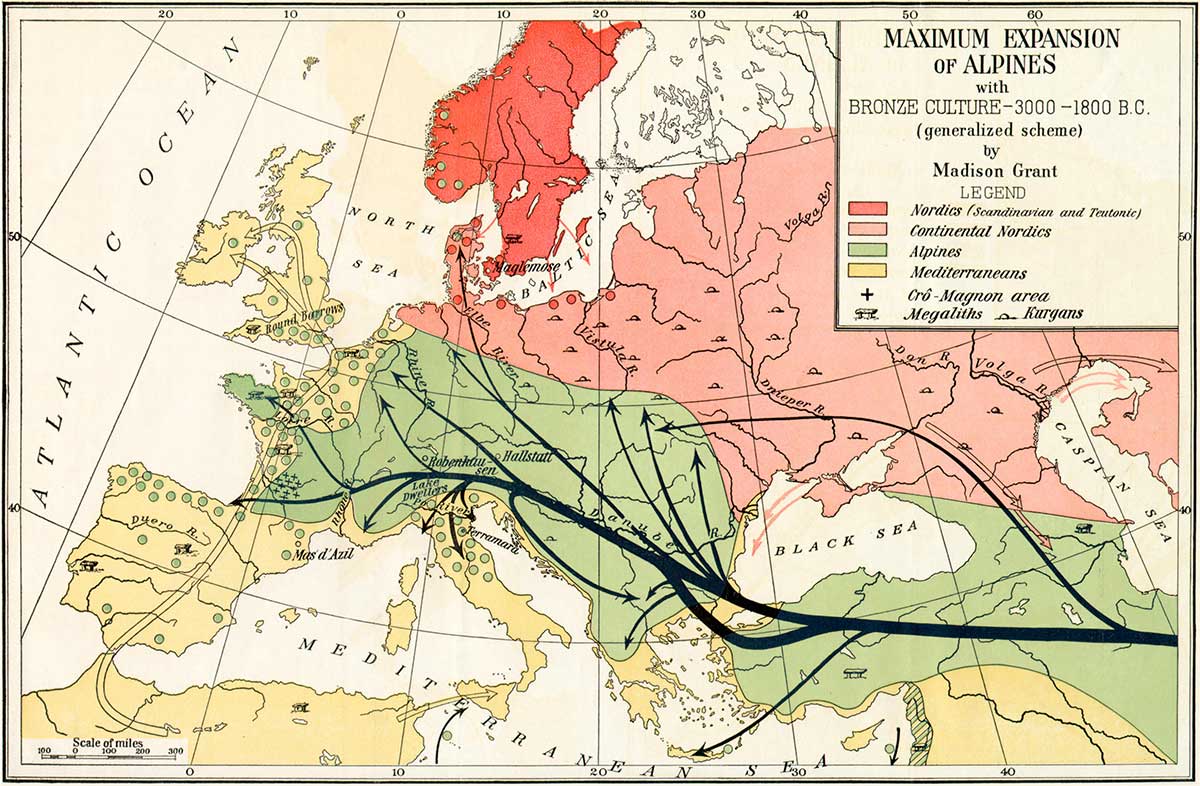
This is just the most obvious tip of the iceberg. There are many examples out there, which are evident to anyone who has had a minimum contact with any forum where population genomics is discussed.
Some of you may question why I use data from people with such evident biases in my papers, and especially why I reference them, if I suspect that there are spurious reasons for everything they write about Indo-Europeans or Uralians. The reason is simple: I use their results (data, analysis), and I disregard their intentions and interpretations. That is, I try to focus on achieving the best possible interpretation, and try not to care about who helps achieve this interpretation.
You can see how many people I reference - in notes if these are informal and/or without a proper study design, or in papers if these are formal or peer-reviewed publications. I cannot possibly base my selection of information on whether the person who publishes said information is a racist, an asshole, or has some serious personality disorder, because that would require from me to do a thorough background checking of all scholars I cite.
It's not easy for me to include them in the text, either, because I feel their names dirty my work to some degree, but I try to always remember that François Magendie was an infamous vivisector whose practices would revolt modern (and most contemporary) spectators, but who is still remembered today because of his studies. Also, from a modern perspective, it is more acceptable to cite a disreputable person than to not attribute authorship.
Conclusion
So, to sum up: is the opposition to the R1b-L23-driven Late Proto-Indo-European expansion a real opposition to its fitting with the described linguistic expansion, to its archaeological or anthropological merits, to the actual raw or processed genetic data...or is it something else?
Would an alien from another planet really doubt that this is the most likely theory, with the current data? I don't think so. In an ideal world, people would like to understand how languages and peoples came to be. In this world, people prefer to promote how they thought/want that those languages and peoples came to be.
The fact is, the IECWT and all of these other alternatives, no matter how beloved they are in certain regions or among certain professionals or amateurs, are not what seems to have happened, with the current data (notice how I repeated this sentence: with the current data). And what matters is who spoke what and when.
NOTE. I don't have any hope that the IECWT will disappear. There is too much interest from academics, nationalists, and genetic fetishists all over Europe for that. But it's like the many conflicting theories before population genomics: we all knew that the steppe homeland theory based on Khvalynsk and Yamna was the most likely one, and still some people liked Anatolia, others Armenia, others Scandinavia, others India, and many didn't like the idea of some 'IE horde' because it reminded them of Nazi ideas, or simply because it didn't fit their desires. Now most people will know that Yamna expanding with patrilineally-related Indo-Europeans, as expected, is the most likely theory. So the fact that certain groups choose to believe otherwise is natural human behaviour.
Anyone who has any experience in chess would know by now (and would have known long ago) that all steps ahead lead to a clear checkmate. Think about it: we have hundreds of samples that point in the same direction; what exactly should happen in future papers to reverse this clear trend? More biased comparisons and p-values? An R1a-Z645 sample of dubious date or cultural adscription in Ukraine? An R1b-L23 sample in late Corded Ware territory? Really? that's what's going to change things??
Exactly. This realization by anyone with common sense that there is no come back to the 2000s is reflected in the growing despair emanating from the unchained comedy of "Corded Ware = Indo-European" theorists. Some people are obsessed with sprinting again and again to demonstrate this or that new pet theory, as more and more papers are published, to try and save previous hypotheses. However, this field is a true marathon that will not end any time soon.
So grab your popcorn and wait for funnier and funnier episodes!
